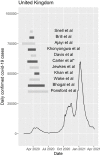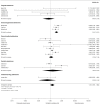A Systematic Review and Meta-Analysis of Inpatient Mortality Associated With Nosocomial and Community COVID-19 Exposes the Vulnerability of Immunosuppressed Adults
- PMID: 34691049
- PMCID: PMC8526940
- DOI: 10.3389/fimmu.2021.744696
A Systematic Review and Meta-Analysis of Inpatient Mortality Associated With Nosocomial and Community COVID-19 Exposes the Vulnerability of Immunosuppressed Adults
Abstract
Background: Little is known about the mortality of hospital-acquired (nosocomial) COVID-19 infection globally. We investigated the risk of mortality and critical care admission in hospitalised adults with nosocomial COVID-19, relative to adults requiring hospitalisation due to community-acquired infection.
Methods: We systematically reviewed the peer-reviewed and pre-print literature from 1/1/2020 to 9/2/2021 without language restriction for studies reporting outcomes of nosocomial and community-acquired COVID-19. We performed a random effects meta-analysis (MA) to estimate the 1) relative risk of death and 2) critical care admission, stratifying studies by patient cohort characteristics and nosocomial case definition.
Results: 21 studies were included in the primary MA, describing 8,251 admissions across 8 countries during the first wave, comprising 1513 probable or definite nosocomial COVID-19, and 6738 community-acquired cases. Across all studies, the risk of mortality was 1.3 times greater in patients with nosocomial infection, compared to community-acquired (95% CI: 1.005 to 1.683). Rates of critical care admission were similar between groups (Relative Risk, RR=0.74, 95% CI: 0.50 to 1.08). Immunosuppressed patients diagnosed with nosocomial COVID-19 were twice as likely to die in hospital as those admitted with community-acquired infection (RR=2.14, 95% CI: 1.76 to 2.61).
Conclusions: Adults who acquire SARS-CoV-2 whilst already hospitalised are at greater risk of mortality compared to patients admitted following community-acquired infection; this finding is largely driven by a substantially increased risk of death in individuals with malignancy or who had undergone transplantation. These findings inform public health and infection control policy and argue for individualised clinical interventions to combat the threat of nosocomial COVID-19, particularly for immunosuppressed groups.
Systematic review registration: PROSPERO CRD42021249023.
Keywords: covid-19; hospital-acquired; immunodeficiency; infection control; nosocomial transmission.
Copyright © 2021 Ponsford, Ward, Stoneham, Dallimore, Sham, Osman, Barry, Jolles, Humphreys and Farewell.
Conflict of interest statement
The authors declare that the research was conducted in the absence of any commercial or financial relationships that could be construed as a potential conflict of interest.
Figures





References
-
- Senior K. Can We Keep Up With Hospital-Acquired Infections? Lancet Infect Dis (2001) 1:8. doi: 10.1016/S1473-3099(09)70294-4 - DOI
-
- England NHS, Improvement NHS. Chief Executives and Chief Operating Officers of All NHS Trusts and Foundation Trusts, CCG Accountable Officers. Minimising Nosocomial Infections NHS (2020).
Publication types
MeSH terms
Grants and funding
LinkOut - more resources
Full Text Sources
Medical
Miscellaneous

